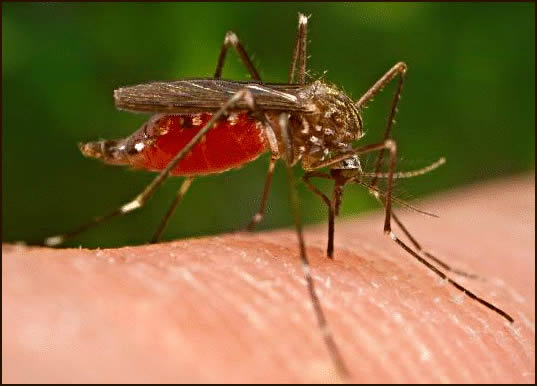
The NMIS report also showed that malaria prevalence is highest among children aged 48 to 59 months and the prevalence is highest in the northwest at 51.6 per cent.
These findings were disclosed on Wednesday in Abuja at the official launch of the NMIS report and the National Advocacy, Communication, and Strategy and Implementation Guide.
The PUNCH reports that malaria is still a major public health challenge in Nigeria despite substantial efforts to reduce the prevalence and impact of the disease.
Other key findings of the report also show that “56 per cent of households own at least one insecticide-treated net. 31 per cent of women aged 15-49 took three or more doses of sulfadoxine-pyrimethamine/Fansider during their last pregnancy. Eight of all children aged six to 59 months have severe anaemia.
“Severe anaemia is most common in the northwest zone. Among children under-five with fever who took an antimalarial, 74 per cent received ACT. 81 per cent of women cited that there are ways to avoid getting malaria; among these 83 per cent cited sleeping under a mosquito net or ITN.”
Speaking at the event, the Minister of Health, Dr. Osagie Ehanire, said malaria accounts for 60 per cent of outpatient visits to health facilities, 30 per cent of childhood deaths, 11 per cent of maternal death (4,500 die yearly), and 25 per cent of deaths in infants (children aged <1 year).
According to the 2021 World Malaria Report from the World Health Organisation, Nigeria contributes 27 per cent to the global malaria burden (one out of every four persons having malaria) and 32 per cent to malaria deaths globally (about one out of every three deaths).
Dr. Ehanire said in Nigeria, about 10 persons die every hour due to malaria or malaria-related issues.
“Children under five years of age remain the most vulnerable group affected by malaria accounting for 67 per cent of all malaria deaths. It is a major cause of school absenteeism and low productivity.
“It is pertinent to note that the Government of the Federal Republic of Nigeria and its partners have made consistent and concerted efforts over the years in providing resources towards the elimination of malaria in the country, and this has resulted to millions of lives being saved. The 2021 World Malaria Report estimates that 1.7 billion malaria cases and 10.6 million malaria deaths were averted worldwide in the period between 2000–2020 and that most of the cases (82 per cent) and deaths (95 per cent) averted were in the WHO African Region,” Ehanire said.
The Minister added that the government with other development partners has implemented three rounds of MIS so far.
“Significant declines have also been observed at the zonal and state levels. The third round of MIS was implemented in 2021, the report of which we are launching today.
“We are seeing gains being sustained in getting the general population to adopt key preventive measures. 56 per cent of households own at least one ITN while 36 per cent of household members, 41 per cent of children under five, and 50 per cent of pregnant women slept under an ITN the night before the survey. 31 per cent of women took at least three doses of SP/Fansidar for the prevention of malaria in pregnancy while 45 per cent took at least two doses up from 17 per cent and 40 per cent respectively in 2018.
“When we look at the percent who slept under an ITN the night before the survey among households with at least one ITN then we see the percentages rise (59 per cent of household members, 64 per cent of children under five, and 73 per cent of pregnant women). This underscores the importance of access, and therefore our drive to use all means including rolling mass campaigns to reach the teaming populations of Nigeria with nets.
“But we have noted that we are still not seeing the substantial gains we wish to see. Malaria prevalence is still higher in rural areas compared to urban areas. We are observing a shift in the disease patterns among the various age groups with prevalence increasing with age, and those more than five years having more episodes of malaria (not tracked in the current NMIS).
“These call for some shifts in the way we do things, especially in promoting health-seeking behaviours within the general populace,” he said.
He added that the Nigeria Malaria ACSM Strategy and Implementation Guide documents the targeting of ACSM interventions at various subnational populations based on their respective epidemiological, ecological, social, and health system contexts.
On her part, the National Coordinator of the National Malaria Elimination Programme, Dr. Perpetua Umomoibhi said while knowledge about how to prevent malaria was high, health-seeking behaviours still lagged.
“Therefore, we need to do things differently to improve the acceptability and uptake of malaria interventions among the populace.
“The goal of the ACSM strategy is to deliver critical activities based on the epidemiological and demographic variations across various states and regions and achieve the desired behaviour at all levels,” she said.
She, however, said malaria interventions had been constrained by the COVID-19 pandemic, increased population, climate change, and inadequate resources.
In his remarks, the Minister of State for Health, Joseph Ekumankama, said the 2021 NMIS report would be used to benchmark achievements of the current National Malaria Strategic Plan of 2021 to 2025.
“Meanwhile, the Nigeria Malaria ACSM strategy and implementation guide 2021-2025 will provide direction in the implementation of ACSM activities to improve the uptake of malaria interventions to ensure the achievements of our targets,” Ekumankama noted.
In his goodwill message, the Chairman of the Malaria Technical Working Group, Dr. Maxwell Kolawole said the National Malaria Strategic Plan aimed to achieve a parasite prevalence of less than 10 per cent and reduce mortality attributable to malaria to less than 50 deaths per 1,000 live births by 2025.
Dr. Kolawole said malaria interventions needed to be adopted by Nigerians as recommended to ensure a greater impact as evidenced by a reduction in malaria prevalence and deaths and attain maximum public health benefits.
“The Advocacy, Communication and Social Mobilisation implementation guide provides a strategy required for a standardised ACSM approach across the country considering the diversity of settings and contexts while maintaining compliance with the minimum scientific standards for ACSM activities,” he said.





